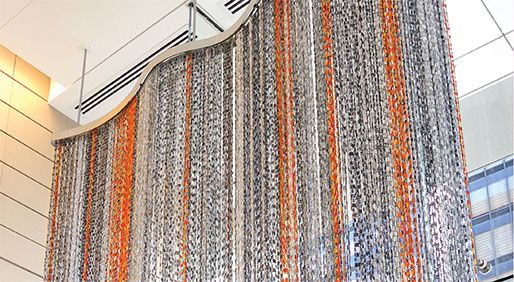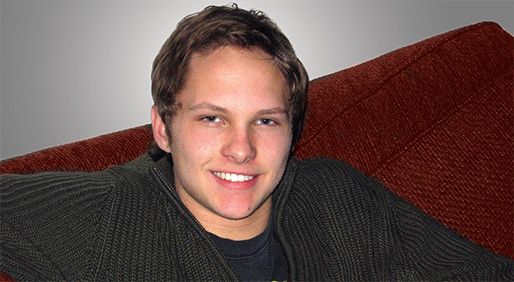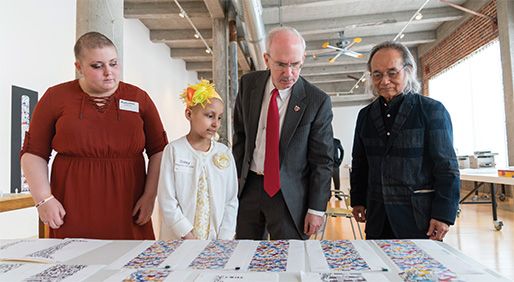Publication
Article
CURE
The Picture of Health: Art Exhibits in Cancer Centers Help Patients and Families Heal
Author(s):
With growing evidence that they can help patients and their families heal, art installations and exhibits are becoming more prevalent in cancer centers.
“Wordfall,” at Memorial Sloan Kettering Cancer Center, is made from 80,000 cascading paperclips wrapped in the words of a young poet who died of cancer, Brendan Ogg.- PHOTO BY GREG STALEY

“Wordfall,” at Memorial Sloan Kettering Cancer Center, is made from 80,000 cascading paperclips wrapped in the words of a young poet who died of cancer, Brendan Ogg. - PHOTO BY GREG STALEY
When Alice Momm, art advisor for Memorial Sloan Kettering Cancer Center (MSK) in New York City, was asked to find a compelling piece of art for the Josie Robertson Surgery Center, MSK’s new outpatient facility that opened in January 2016, her first idea was a sculpture for the outdoor terrace. But when she found out that the art would be competing with a large sign announcing the name of the facility, she realized she would have to rethink that concept.
When looking for art for MSK, Momm often turns to gallery owner Susan Eley. This time, Eley suggested exploring the work of an artist she represents, Francie Hester, who is based in Silver Spring, Maryland. Checking out Hester’s website, Momm gravitated toward an installation consisting of strands of 40,000 paperclips falling from a curved rod, exhibited at the Howard Hughes Medical Institute’s Janelia Research Campus in Chantilly, Virginia. Hester had produced the work with her artistic partner, Lisa Hill, with whom she often collaborates.
“On a visual level, the piece at Howard Hughes was welcoming, beautiful, intriguing, and it moved and changed with the light,” Momm explains. “I was thrilled when the design committee for the MSK facility commissioned a new version of the installation.” Larger than the Howard Hughes piece, the MSK installation, called Wordfall, is built from 80,000 paperclips that create strands cascading from the ceiling and almost reaching the floor.
“Wordfall is simple, clean and modern, and softened the feel of the space. It also creates a beautiful shadowing effect in the lobby,” Suzen Heeley, executive director of design and construction at MSK, recalls.
Brendan Ogg

Brendan Ogg
IN REMEMBRANCE OF A POET
Wordfall was conceived as a memorial to Brendan Ogg, a young man from Silver Spring who died from a brain tumor in 2010, at the age of 20. Following his diagnosis, Brendan found spiritual solace in art, especially poetry, which became his way of coping with his illness.
“Brendan was an old soul — and a gifted writer who had been focusing on poetry before his diagnosis,” Brendan’s mother, Jackie, notes. “Attending a half-day poetry workshop at the Smith Center for Healing and the Arts in Washington, D.C., helped him rediscover his voice.” Shanti Norris, director of the Smith Center, facilitated that workshop and recalls that “Brendan became on fire. All of us sat there and listened to him read. He was finding something rich and beautiful in himself. We all felt privileged to be there to witness his moment of self-discovery.” It would not be an overreach to say that Brendan had truly become a poet.
Shortly before Brendan died, the family found out that a book of his poems was going to be published by Finishing Line Press. “We are so grateful that Brendan lived long enough to know this would happen and to have a hand in the final edits to the book, Summer Becomes Absurd,” Jackie notes.
Brendan Ogg, who lost his battle with cancer at the age of 20, was a poet who had authored a book of poems, Summer Becomes Absurd (Finishing Line Press, 2010). Recently, bits and pieces of his work were interwoven into the sculpture Wordfall, on display at Memorial Sloan Kettering Cancer Center, in New York. Snippets of the poems, on small pieces of paper, are wrapped around the paperclips that are the centerpiece of the sculpture. Here are two of the poems from Ogg’s book:
L'chaim
(“to life”)
Feather rug, soft bed of matted grass,
Why did I question this place of endless beauty—
life—
to my friend, in weakness?
Where was my heart before this time?
Now I feel it in my breast.
Put your hand there, fingers spreading from the palm,
And feel the warm, insistent pulse.
Keep Me From Fear
Keep me from fear,
that cold paralysis,
the squirming nausea.
I am sick of these half eaten fingernails. No.
I have my whole life to be afraid.
There! With that declaration, the anvil weight of dread
falls loosely from the chain around my neck.
I have my entire life, however long it is.
I have my own eternity in a hundred years, or in an instant. But Brendan’s friends wanted to do even more. Hester, whose son was one of Brendan’s best friends, came up with the idea of wrapping small pieces of paper printed with the poet’s words around paperclips and using those clips as the central element of Wordfall. Inviting Brendan’s friends and family to come together in wrapping circles, Hester and Hill viewed this phase as part of the creative process. “The circles were really magical,” Hill says. “People started talking, sharing and engaging in their own healing.”
Within Sloan Kettering, the piece has resonated. In fact, a second installation, Wordfall: Currents, has been for the recently opened Teen and Young Adult Lounge. The lounge is geared to cancer patients and survivors between the ages of 15 and 30, a group that often gets lost in the shuffle between pediatric cancer patients and older adults. Funded in part by Teen Cancer America, an organization founded by Roger Daltrey and Peter Townshend from the rock band The Who, the lounge will be a flexible space offering computers, video games, movies and hands-on activities. What’s more, young cancer patients and survivors will be wrapping the paperclips around Ogg’s words, helping to create the art designed specifically for them, in memory of one of their own.
At an event introducing the concept for the 80-foot sculpture at University of Nebraska Medical Center, artist JUN KANEKO, right, discusses the work with attendees. - IMAGES COURTESY OF NEBRASKA MEDICINE

At an event introducing the concept for the 80-foot sculpture at University of Nebraska Medical Center, artist JUN KANEKO, right, discusses the work with attendees. - IMAGES COURTESY OF NEBRASKA MEDICINE
RESEARCH FUELS GROWING INTEREST IN ART
Since the late 1980s, a growing body of research has documented the healing power of art. In a landmark study published in 1984, Roger S. Ulrich, professor of architecture at the Center for Healthcare Building Research at Chalmers University of Technology in Sweden, found that patients who had undergone a surgical procedure and could look outside and see trees recuperated almost a full day earlier than those who had no access to the outdoors. In a 1993 follow-up randomized study, also conducted by Ulrich and his colleagues, the researchers found that patients assigned to a room with nature images on the wall had less postoperative anxiety and were more likely to switch from strong painkillers to weaker ones than patients in a room with abstract art or no images at all.
More studies have followed, including one published in 2013 that built on the “window” idea. The randomized “open window” study found that patients with blood cancers being treated in a hospital stem cell transplant unit, if provided with “virtual windows” that displayed art, videos and photographs and played music, experienced significantly less depression and anxiety and had more positive expectations about the procedures they were there to undergo.
Early hospital-based art programs reflected the initial research findings of this kind. When Tina Mullen joined the University of Florida Health (Gainesville) Shands Arts in Medicine program in 1990, her goal was “to bring the outside world into the hospital environment. We had a strong awareness of nature and light, with a focus on greens, blues, wood tones, creams and browns,” she says. “The work we chose then, and continue to look for, talks about the human experience and our relationship with the natural environment.”
The UF Health Shands Arts in Medicine program also reached out to the community, bringing artists into the hospital to engage with patients and their families. Senior leadership noticed the positive impact both the artists and their work had on the hospital environment, so they encouraged Mullen and her team to integrate art into renovations of buildings throughout UF Health. “As an institution, we are driven to bring art to our patients,” Mullen says. “It brings the human touch to hospital care.”
Sometimes, art programs encourage patients to create their own art, which not only serves to give patients a voice but also brings unique work to a hospital space. Cindy Perlis, founder and director of the Art of Healing program at the University of California, San Francisco’s Helen Diller Family Comprehensive Cancer Center, initiated a quilt project in 1992 for women with breast cancer living in multiple underserved communities, as well as in the county jail.
“We presented multiple art workshops throughout the Bay Area for many years,” Perlis says. “We brought dinner and art materials, and then each woman created her own quilt square that was sewn into a larger quilt. Each quilt had between 15 and 25 squares, and they were beautiful.” There are now 70 quilts in the collection. Some are part of traveling exhibitions, and others are on permanent display at UCSF Medical Center’s new Mission Bay Hospital.
Elaine Sims, director of the Gifts of Art program at the University of Michigan Health System and another pioneer in the field, also recognizes the importance of art to the patient experience. She initiated a program called Art Cart, a lending library of framed posters for patients’ rooms. As its name suggests, volunteers take a cart around the hospital twice a week, giving patients a chance to pick out a piece of art for their rooms. The art can help patients build a new narrative, and sometimes gives them the courage to face a dire prognosis.
“I remember a gentleman with inoperable brain cancer,” Sims says. “A former World War II bomber pilot, he was going into hospice and insisted on taking his poster with him. It was a little girl in a tutu, with a nutcracker in her hand.” ‘She’s the gutsiest gal I know,’” Sims recalls him saying. “‘She’s going with me.’”
In addition to the Art Cart program, the University of Michigan has nine galleries whose exhibits are changed every three months. Sims notes that she hears from staff that patients come down at night to look at the artwork hanging on the walls. “When people are adrift in a scary place, they often glom onto art,” Sims says. “It helps normalize their experience and reassure them that things are going to be OK.”
FIELD COMING OF AGE
As evidence of art’s importance to the healing process continues to mount, some institutions are allocating space and resources to build even more robust programs. Cleveland Clinic in Ohio is a case in point. It has an eclectic collection of 6,000 works of art, including paintings, prints, works on paper, photography, sculpture and videos. The diverse collection is composed of abstraction, landscape and conceptual and representational imagery.
“The art encompasses different themes, including those that explore the human condition and spirit,” says Joanne Cohen, executor director of the Cleveland Clinic Art Program. “A patient’s interaction with a piece of art represents a moment of beauty and levity, when a patient can go and think about something other than their illness. It also is practical. We use art as a wayfinding device to help patients who may be stressed out and anxious (to) navigate the space.”
Although Cohen and her team were aware of the research on the positive role of art, they didn’t have evidence that the eclectic approach they were taking was beneficial. To fill that gap, the institution conducted its own research in 2014 on the impact of art on the patient experience. After collecting and analyzing surveys from 1,094 patients, the team concluded that “patients may respond positively to the diversity of the collection, and to other types of art in addition to nature art.”
The team gained insight into who was drawn to the artwork and how it affected them. Overall, close to 75 percent of all respondents noticed the artwork, with 81 percent of those between the ages of 35 and 44 noticing it the most.
The study also divided responses by type of illness, with cancer patients identified as one subgroup. Interestingly, cancer patients reported a 65 percent improvement in their stress levels after viewing the art, with breast cancer patients noting a 75 percent improvement. About 43 percent of all cancer patients said the art improved their pain and comfort levels.
One piece of art was singled out by respondents, a video installation called Mike Kelly I, by artist Jennifer Steinkamp. Located adjacent to the main lobby, the projection shows an animated tree continuously cycling through the seasons. One respondent noted that her aunt, who had terminal cancer and was confined to a wheelchair, liked to sit and watch the tree as it changed. This piece has proven to be so popular that seating has been added to accommodate the number of viewers.
These findings have helped inform the design of Cleveland Clinic’s new cancer center, scheduled to open in 2017. According to Cohen, the plan is to acquire 120 pieces of art, along with 1,500 fine art posters and 10 site-specific installations.
One of the most striking installations is a series of lightboxes for a seven-story bank of elevators. Conceived by Spencer Finch, the installation is inspired by a cyanometer, an instrument developed in Switzerland in the 18th century to measure the blueness of the sky. To create the piece, Finch plans to climb a mountain in the Rockies, measuring the shades of blue he finds at each height. In turn, each of the installation’s lightboxes will emit a corresponding shade of blue that he captured during his hike. “We felt that the concept resonated with the experience of being a patient, which can feel like climbing a mountain,” Cohen says.
The University of Nebraska Medical Center in Omaha is also building a new cancer center, called the Fred & Pamela Buffett Cancer Center, slated to open in 2017. A central part of the new center is its comprehensive Healing Arts Program, designed “to integrate arts with medicine,” says Kenneth Cowan, the cancer center’s director. “We believe that the arts can provide an important avenue for providing comfort and relief, reducing tension and offering hope, all as a way to increase the healing process.”
The cancer center has already commissioned two large installations by world-class artists. Search, an 80-foot tower at the front of the building, is being developed by Jun Kaneko, a Japanese-born artist who has made his home in Omaha. The tower will be made of hand-blown glass in vibrant colors resting on a background of black-and-white markings that “closely resemble the pattern of human chromosomes,” Cowan says. “Amazingly, he wasn’t aware of that connection when he conceived the pattern.” Kaneko’s hope for the piece is that it will evoke a “wow” response from viewers and be a source of positive energy and visual engagement.
Dale Chihuly has enjoyed tremendous success as an artist working in glass, and he has built many installations for a wide array of art museums worldwide. But when asked if there was one thing he would still like to do, he replied that he would like to build a chapel similar to the Matisse Chapel in the South of France. His chapel, named the Chihuly Sanctuary, has found its home at the cancer center, and will serve as a place of meditation for both patients and staff.
The sanctuary will be shaped like a cone, inspired by Chihuly’s iconic Macchia series, a collection of glass-blown sculptures. The chartreuse color of the roof is also a nod to his previous work. The exterior will be a warm yellow tone, designed to welcome all visitors to the sanctuary. The interior will include a series of specially colored flowers and wood panels. “Chihuly envisions hundreds and hundreds of pieces of glass, lit from all sides to create shadows and beautiful images in the room,” Cowan notes.
The sanctuary will be the gateway to another centerpiece of the cancer center — Leslie’s Healing Garden, in memory of Marshall and Mona Faith’s daughter, who died of leukemia nearly 60 years ago, when she was only 2 years old. The family is funding the garden as a memorial to their daughter, whom they remember as very spiritual and drawn to nature. The family feels that Leslie would have loved a place to go to rest and recover after one of her procedures. The garden will have a heated pathway so it can be used all year round, and will also feature flowers and evergreens with twinkling lights.
“I like to think of the garden as a way to put Leslie’s name into the future,” says her father, Marshall Faith. His sentiments echo those of the Ogg family and the artists who conceived Wordfall in memory of another young person who died far too soon.
Patients and their families aren’t the only ones whose lives can find a new direction through art. Cowan believes that researchers can benefit as well.
“Perhaps the creativity they see in the artwork around them will spur their scientific work,” he says, “encouraging them to look at research in a new, and perhaps groundbreaking, way.”






